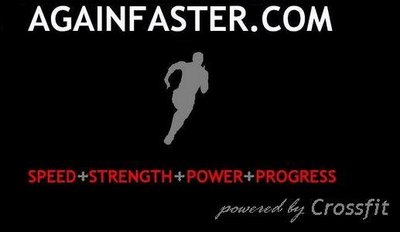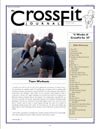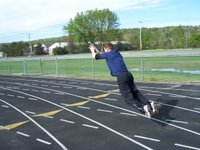Embrace the Pain

With Crossfit, physical proficiency comes quickly. A year into the program, an athlete who was overweight, weak, and deconditioned can expect to be lean, strong, and resilient.
Hesitancy and doubt are replaced by confidence and competency, and novel challenges become opportunities rather than obstacles. Somewhere along that path, the athlete realizes that progress is not limited by bodily capability—it is limited by mental capacity.
Becoming a top-tier athlete requires one to balance on the precarious edge between self-preservation and self-annihilation. The intelligent athlete leans toward preservation, as this ensures progress rather than injury. The problem comes when that athlete shies too far from the edge, forgetting that the body is a very hard thing to break.
This leads to the dreaded “sandbagging”—performing below maximum capacity in the name of self-preservation. I’m often faced with experienced athletes who give ninety percent rather than one-hundred percent. This is not a conscious act, but rather a syndrome that comes from two sources: the brain telling the body to stop and the athlete’s inability to override that signal.
Your brain is responsible for keeping you alive, and tends to overreact to external and internal stimuli. It sends pain signals to your conscious mind long before your body reaches mortal danger, and it does so for a very good reason: it doesn’t want you anywhere near death. The larger the margin (and the sooner you quit), the less likely it is that you’ll approach this point.
To reach the upper echelons of athletic performance, you must ignore this signal. Most athletes are nowhere near their breaking point, and can afford to do this.
Instructing your brain to shut up is as simple as short-circuiting the pain process. During intense exercise, your mind is blank and receptive. There is a virtual absence of conscious thought, allowing pain signals to come through like ambulance sirens. You have to add to the noise, dulling the incoming signals. You have to think.
Count your repetitions out loud. This will occupy your thought processes and prevent the wailing from shutting you down. Similarly, count your breaths during rest breaks. When fatigue forces you to put the weight down, give yourself five breaths and get back to it. The counting process will achieve two aims—it will drown out the pain signals and limit your mid-workout downtime.
This combination will inevitably lead to better WOD times.
I experimented with this process during a workout involving 150 repetitions of the most painful exercise on Earth—the dumbbell thruster. The athletes using a five-breath rest period and continuous counting decimated the times posted by an earlier group, exhibiting decisively superior power output. The better-performing athletes were less experienced than their competitiors, and by all accounts should have handed in less impressive performances.
Elite performances are predicated on pain tolerance. Discomfort must be embraced and overcome, and the brain must be retrained to send pain signals at higher and higher thresholds. As your body evolves, your mind must keep pace. If you can achieve this synergy, the mind and body will continually drive each other to new heights of athleticism.
Go faster!
Sisyphus charcoal courtesy of jillgeorgegallery.co.uk. Image edited by Again Faster.

With Crossfit, physical proficiency comes quickly. A year into the program, an athlete who was overweight, weak, and deconditioned can expect to be lean, strong, and resilient.
Hesitancy and doubt are replaced by confidence and competency, and novel challenges become opportunities rather than obstacles. Somewhere along that path, the athlete realizes that progress is not limited by bodily capability—it is limited by mental capacity.
Becoming a top-tier athlete requires one to balance on the precarious edge between self-preservation and self-annihilation. The intelligent athlete leans toward preservation, as this ensures progress rather than injury. The problem comes when that athlete shies too far from the edge, forgetting that the body is a very hard thing to break.
This leads to the dreaded “sandbagging”—performing below maximum capacity in the name of self-preservation. I’m often faced with experienced athletes who give ninety percent rather than one-hundred percent. This is not a conscious act, but rather a syndrome that comes from two sources: the brain telling the body to stop and the athlete’s inability to override that signal.
Your brain is responsible for keeping you alive, and tends to overreact to external and internal stimuli. It sends pain signals to your conscious mind long before your body reaches mortal danger, and it does so for a very good reason: it doesn’t want you anywhere near death. The larger the margin (and the sooner you quit), the less likely it is that you’ll approach this point.
To reach the upper echelons of athletic performance, you must ignore this signal. Most athletes are nowhere near their breaking point, and can afford to do this.
Instructing your brain to shut up is as simple as short-circuiting the pain process. During intense exercise, your mind is blank and receptive. There is a virtual absence of conscious thought, allowing pain signals to come through like ambulance sirens. You have to add to the noise, dulling the incoming signals. You have to think.
Count your repetitions out loud. This will occupy your thought processes and prevent the wailing from shutting you down. Similarly, count your breaths during rest breaks. When fatigue forces you to put the weight down, give yourself five breaths and get back to it. The counting process will achieve two aims—it will drown out the pain signals and limit your mid-workout downtime.
This combination will inevitably lead to better WOD times.
I experimented with this process during a workout involving 150 repetitions of the most painful exercise on Earth—the dumbbell thruster. The athletes using a five-breath rest period and continuous counting decimated the times posted by an earlier group, exhibiting decisively superior power output. The better-performing athletes were less experienced than their competitiors, and by all accounts should have handed in less impressive performances.
Elite performances are predicated on pain tolerance. Discomfort must be embraced and overcome, and the brain must be retrained to send pain signals at higher and higher thresholds. As your body evolves, your mind must keep pace. If you can achieve this synergy, the mind and body will continually drive each other to new heights of athleticism.
Go faster!
Sisyphus charcoal courtesy of jillgeorgegallery.co.uk. Image edited by Again Faster.




















2 Comments:
Awesome post, Jon. I'm passing this around work as we speak. Very fitting in my environment. Sometimes, my "clients" have never experienced exertion before, so the key is teaching them that pain is OK, you can go farther, faster.
Great article Jon, hope to see you down in Topsfield again soon.
Post a Comment
<< Home